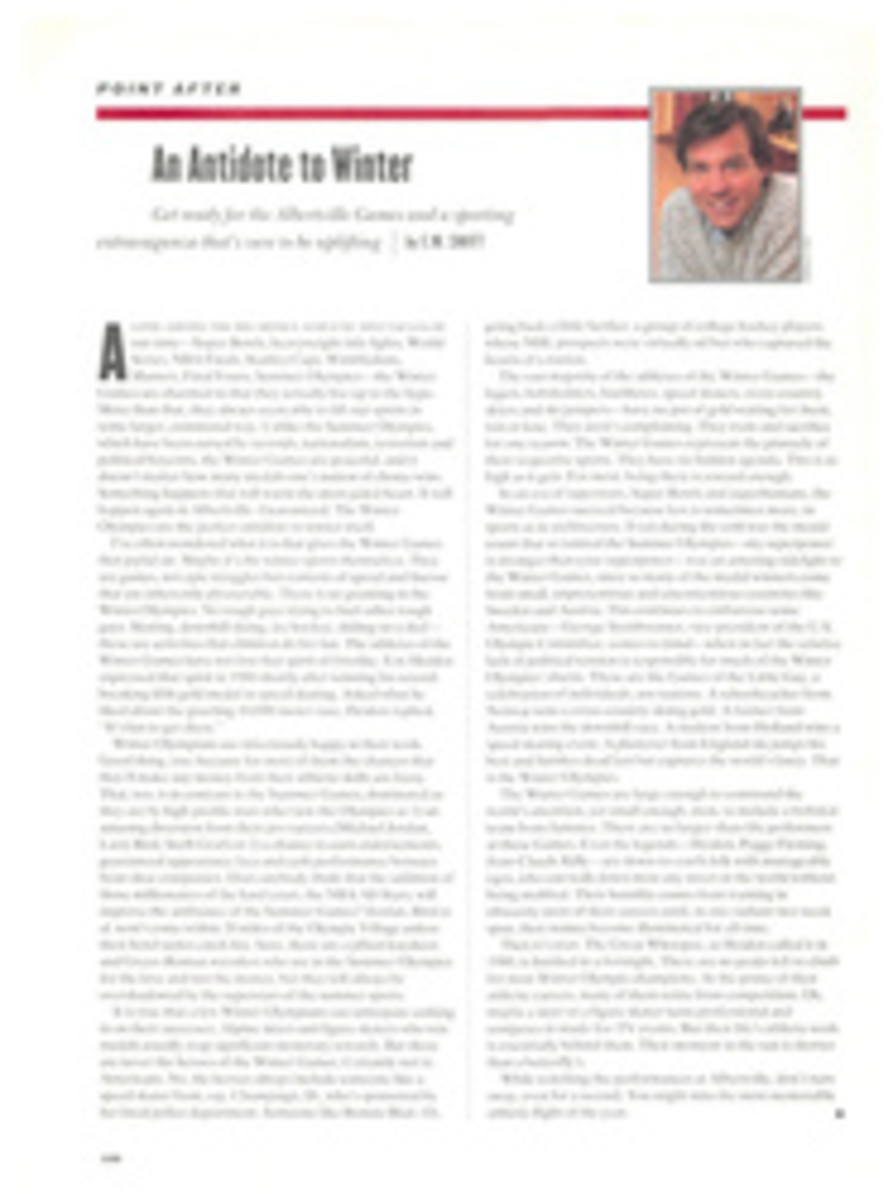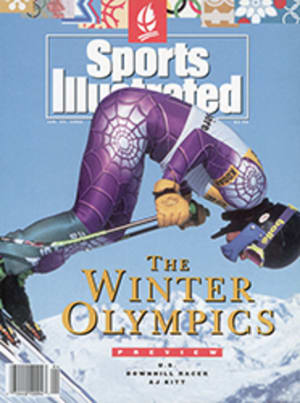
THE WHOLE KITT AND CABOODLE
On January 15, 1984, a redoubtable loudmouth and former juvenile delinquent named Bill Johnson won the Lauberhorn downhill in Wengen, Switzerland, to become the first American man to win a World Cup downhill race since the World Cup began in 1966-67—a span covering some 140 races. Further, no U.S. male had finished better than fifth in any world championship or Olympic downhill dating all the way back to 1936. As a deeply offended ski-racing world can never forget or forgive, after Johnson broke the barrier in Wengen, he started bragging like a truly ugly American and didn't stop until he had gone on to make good on his boasts by winning the Olympic gold medal in Sarajevo a month later, as well as two more World Cup downhills that same year.
Now, eight years and some 70 downhills later, a second American has won a World Cup downhill, and once again an Olympics awaits him. This U.S. victory occurred on Dec. 7, 1991, in Val d'Isère, France, and the winner was a redoubtable dead-solid opposite of the motor-mouth of Sarajevo—Alva Ross Kitt IV, who is known as AJ.
Kitt is 23, the same age Johnson was when he won in '84. There the resemblance pretty much ends. The California-born Johnson came from a broken home and was a chronic misfit and troublemaker both in school and as a member of the U.S. ski team. He was an outspoken though often charming young man who, when asked at a Sarajevo press conference what winning the gold medal meant to him, replied, "Millions. We're talking millions."
Opinions of Johnson among U.S. sportswriters in Sarajevo varied widely. They ranged from dark predictions for his future ("There's a gold medal that's going to end up in a pawn shop") to cheerleading over the rags-to-riches quality of his victory ("My god, just think, the kid is damn near sent up the river to the big house [for stealing a car in 1977], then turns himself around and wins the gold medal! How American can you get?").
Kitt generates no such comments. He is a well-behaved, hardworking young man who grew up Gates, N.Y., a well-scrubbed suburb of Rochester, the only child of Alva Ross Kitt III, who operates a 30-year-old family law-book-publishing firm, and his wife, Nancy. Though Ross, as the father calls himself, is a Rochester native and Nancy is from Minnesota, they both graduated from the University of Colorado and became certified ski instructors when they moved east. "It was not only a way to enjoy the sport, but a way to afford it," says Ross.
It also turned out to be a way that, at age two, AJ could begin making ski turns free of charge on the nonperilous terrain of the tiny Frost Ridge ski area, 15 miles outside Rochester. "It has a vertical drop of about 100 feet," says Nancy, "and it had a little rope tow run by a tractor engine when we started there with AJ."
For the record, AJ—sans periods—stands for nothing at all. There have been reports that it is short for Alva Jr. or for Angel Jesus. The latter theory rises from European tabloids' having reported that the Kitts are fanatical Mormons. This makes AJ's father furious. "We aren't Mormons, and we aren't into religion," says Ross. "We picked 'AJ' just because the letter combination of A and J sounded good to us. No other reason."
As a youngster AJ won some age-group races in New York, and at 14 he enrolled at the Mountain House School (now the National Sports Academy) in Lake Placid, where he could train year-round. As Dave Wenn, dean of students and head Alpine coach there, recalls, "AJ wasn't a naturally gifted skier. Mainly he was good because he was big for his age and went really fast, but he wasn't able to turn a ski well. He had to work very hard on technique. His expectations were definitely beyond his ability, but he really wanted help and guidance. He was focused. And he was a joy to coach. By comparison, I had Bill Johnson at the school some years before AJ. I never saw a more disrespectful, uncoachable know-it-all."
Kitt's five-year career on the U.S. ski team has proceeded with a minimum of sound and light. Before the 1991-92 season his best previous World Cup downhill performances were a pair of fourth-place finishes. In last year's world championships in Saalbach-Hinterglemm, Austria, he did no better than 20th, and he finished 18th in the '90-91 World Cup downhill standings. Hence the victory at Val d'Isère was a surprise to many observers.
Kitt, though, sees it as merely a matter of logical progression. "Over the past four years things have been accumulating," he says. "My physical condition was better every year, and my technique was improving. Now that I've won a race, there is a definite psychological change. Last year I wanted to be in the top 15 every race. Now I want to be in the top five. I'm on a whole different level."
Sure enough, Kitt got a fourth place in a World Cup race on Dec. 14 in Val Gardena, Italy, then an eighth place at Garmisch, Germany, on Jan. 11, and a nondescript 15th followed by a spectacular second last weekend in Kitzbühel, Austria. His Val d'Isère victory was greeted with extra exultation in the U.S. because it happened in the same village where the Olympic downhill will take place, weather willing, on Feb. 9. However, the Val d'Isère course Kitt won on is not the same one on which the Olympic downhill is scheduled. The old World Cup run, which has been in use for more than 30 years, is supposed to be replaced by a new Olympic course that was laid out by Bernhard Russi, the former Swiss downhill great. Because of some streaks of bad weather, Russi's course has never been used in World Cup competition, so the Olympic downhill would be its first international event.
The course is called La Face de Bellevarde, and it begins with the kind of harrowingly steep free fall that every downhiller loves. Then it suddenly becomes turny and slow, the kind of turgid configuration that every downhiller hates. Karl Alpiger, a Swiss downhiller, told Snow Country magazine his opinion of La Face: "To me, a good downhill has fast long turns, short tight turns, a really fast straight part and, of course, good jumps. What we have in this new course is slow speeds, tight turns and no fast flat part."
Kitt does not disagree. "The first 25 seconds are real good, but then you hit this jump where you have to slow way down, and that pretty much ruins it from then on," he says. "There are other problems inherent in the nature of the terrain. It's tough to keep snow on the parts of it that are too steep and too narrow for Sno-Cats to pack snow. And the light is a big problem. If it isn't clear, the light is so flat you can't see the ground, and that can get you in trouble, because if you're thrown off only two inches in one of those bumps, you land on your back."
Unlike the '84 downhill course at Sarajevo, which was mostly flat and straight—precisely to Johnson's liking—Russi's run, with its tighter, Super G-type turns, does not play to Kitt's strength. Both Val d'Isère downhills are being prepared for the Olympics, in case La Face cannot be raced. If the old course is used, Kitt will be one of the favorites. If La Face is in shape, older and more technically accomplished skiers will be favored, such as Switzerland's Franz Heinzer, France's Franck Piccard and Luxembourg's Marc Girardelli, a four-time overall World Cup winner and the only male skier in history to have won a race in all five Alpine disciplines.
Among the American ski racers who will be in Albertville, Kitt has the best—though not the only—chance to win a medal. It is worth remembering that Johnson's gold in Sarajevo was only one of five medals that U.S. ski racers brought home from those Games. Debbie Armstrong won the women's GS and Phil Mahre the men's slalom, and silvers went to Christin Cooper in the women's GS and to Phil's twin brother, Steve, in the men's slalom. Also worth remembering is the fact that at the '88 Olympics in Calgary the top finish for a U.S. skier was ninth. The Americans' performance in Albertville will probably fall somewhere between those extremes.
No other U.S. male skier is within shouting distance of Kitt. The U.S.'s top female skiers are within shouting distance—just. After a series of injuries last season that decimated the women's team, some world-class racers are back at work. Diann Roffe, 24, a gold medalist at 17 in the '85 world championship GS in Bormio, Italy, survived a bad knee injury last year, and this World Cup season she has flirted with winning, finishing high on several occasions in the GS and the Super G. Eva Twardokens, 26, who got the bronze in that same Bormio GS, has racked up a fifth and a ninth in the GS this season and was fifth in the world championship GS in Saalbach last year. Julie Parisien, 20, is a stirring newcomer who won the GS in Waterville Valley, N.H., last spring to become the first American of either sex to finish first in a World Cup event since 1987. Last week she had a third and a fifth in the slalom, an indication that she may be peaking at the right time.
U.S. skiers have suffered through several bleak years. The team's administration has been somewhat chaotic, and there is a helpless feeling of bitter bad luck about all the injuries. Could a reversal of fortunes be in the cards? Maybe. Kitt's hard-earned success in the fastest, flashiest ski-racing event of them all could be a signal that nice guys are going to start finishing first—at last.
PHOTO
HEINZ KLUETMEIER
KITT GAVE AMERICAN HOPES A MAJOR LIFT LAST-MONTH AT VAL D'ISÈRE.
PHOTO
CARL YARBROUGH
OVERALL, THE U.S. WOMEN—(FROM LEFT) KRISTI TERZIAN, ROFFE, PARISIEN AND TWARDOKENS—ARE STRONGER THAN THE MEN.
PHOTO
HUBERT SCHRIEBL
LAST MARCH, PARISIEN BECAME THE FIRST U.S. WORLD CUP WINNER SINCE '87.
TWO PHOTOS
ILLUSTRATION

